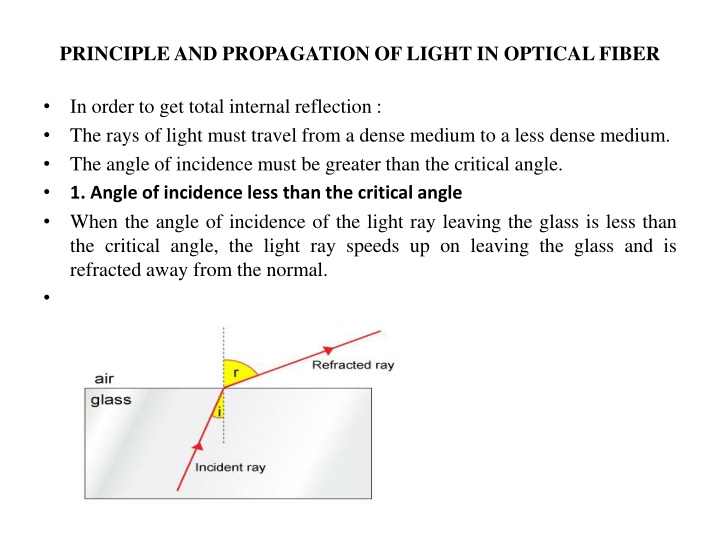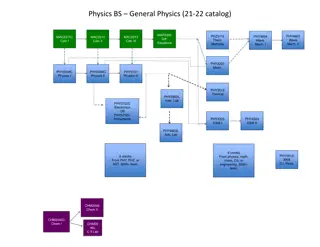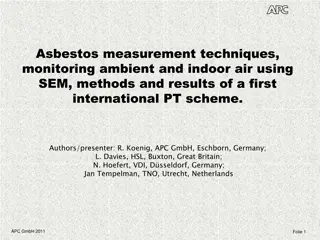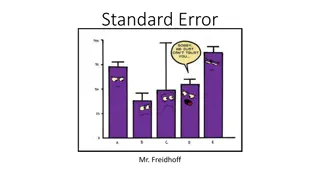
Light Principles and Optical Fiber Classifications
Explore the principles of light propagation in optical fibers, including total internal reflection at different angles of incidence. Learn about the types of optical fibers based on materials and classifications. Glass fibers and plastic fibers are discussed along with their advantages and examples.
Download Presentation

Please find below an Image/Link to download the presentation.
The content on the website is provided AS IS for your information and personal use only. It may not be sold, licensed, or shared on other websites without obtaining consent from the author. If you encounter any issues during the download, it is possible that the publisher has removed the file from their server.
You are allowed to download the files provided on this website for personal or commercial use, subject to the condition that they are used lawfully. All files are the property of their respective owners.
The content on the website is provided AS IS for your information and personal use only. It may not be sold, licensed, or shared on other websites without obtaining consent from the author.
E N D
Presentation Transcript
PRINCIPLE AND PROPAGATION OF LIGHT IN OPTICAL FIBER In order to get total internal reflection : The rays of light must travel from a dense medium to a less dense medium. The angle of incidence must be greater than the critical angle. 1. Angle of incidence less than the critical angle When the angle of incidence of the light ray leaving the glass is less than the critical angle, the light ray speeds up on leaving the glass and is refracted away from the normal.
LIGHPRINCIPLE AND PROPAGATION OF T IN OPTICAL FIBER 2. Angle of incidence equal to the critical angle When the angle of incidence of the light ray reaches the critical angle (42 ) the angle of refraction is 90 . The refracted ray travels along the surface of the denser medium in this case the glass.
LIGHPRINCIPLE AND PROPAGATION OF T IN OPTICAL FIBER 3. Angle of incidence greater than the critical angle When the angle of incidence of the light ray is greater than the critical angle then no refraction takes place. Instead, all the light is reflected back into the denser material in this case the glass. This is called total internal reflection.
TYPES OF OPTICAL FIBRES Optical fibres are classified into three major types based on (i) The material, (ii) Number of modes and (iii)Refractive index profile (or) Variation in the refractive index
CLASSIFICATION BASED ON MATERIALS BASED ON THE MATERIALS optical fibres are classified into (i) Glass fibres and (ii) Plastic fibres. Glass fibres If the optical fibres are made from fusing mixtures of metal oxides and silicon glasses, they are known as glass fibres. Examples: Core + Cladding SiO2 + P2O3 SiO2 GeO2 SiO2 + SiO2 SiO2 + B2O3 SiO2
CLASSIFICATION BASED ON MATERIALS BASED ON THE MATERIALS (ii) Plastic fibres If the optical fibres are made of plastics, they are called plastic fibres. Examples: Core + Cladding Polymethylmetha crylate + Co polymer Polystyrene + Methylmetha crylate Advantages Plastic fibres are cheap They can be handled without any care due to their toughness and durability.
CLASSIFICATION BASED ON NUMBER OF MODES On the basis of the modes of propagation, optical fibres can be classified into two types. They are, (i) Single mode fibres and (ii) Multimode fibres Single mode fibres In the single mode fibres, the diameter of the core is very small of the order of 5 to 10 m. So, it allows only one mode of propagation of light waves. Hence it is called as "single mode fibre". That means light travels in this mode along a single path, that is along the axis. The diameter of the cladding is very large of the order of 125 m when compared with the diameter of the core. Hence this type of fibre can be used for long distance communication.
CLASSIFICATION BASED ON NUMBER OF MODES Multimode fibres Here the diameter of the core is very large of the order of 50 to 350 m when compared with the diameter of the core in single mode fibres. So, it allows many modes of propagation of light waves. Hence it is called as "Multimode fibre". The diameter of the cladding is also very large when compared with the diameter of the cladding in single mode fibres. As a result, light travels in zig-zig paths. The numerical aperture of multimode fibre is larger as the core diameter is larger. This is useful in short distance communication.
CLASSIFICATION BASED ON REFRACTIVE INDEX Based on the refractive indices of core and the cladding, optical fibers are classified into two types. They are (i) Step index fibre and (ii) Graded index fibre. Step index fibre In the step index optical fibre the core has a uniform refractive index and the cladding has also a uniform refractive index . But n1 > n2. Let a and b be the radii of core and cladding respectively. The refractive index changes abruptly at the core-cladding interface and the refractive index profile is in the shape of a step. Hence, this fibre is called step index fibre. The refractive index profile of step index fibre is shown in Figure.
CLASSIFICATION BASED ON REFRACTIVE INDEX Graded index fibre If the core has a non-uniform refractive index that gradually decreases from the centre towards the cor-cladding interface, the fibre is called graded index fibre. The cladding has a uniform refractive index. The refractive index profile of graded index fibre is shown in Figure. Applications It is widely used in intra-city trunks between central telephone offices. It is used in medium distance communications. It is used for communication in submarine cable system.






















